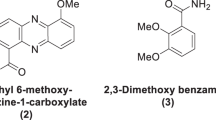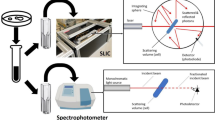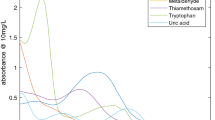Abstract
WE have obtained these records with the 'différentiel bio-photomètre' recently built by Bonét-Maury and Walen1 in the Radium Institute, Paris; that apparatus automatically records the variations of opacity of six bacterial suspensions. The growth of the micro-organisms is carried out at 37° C., in special 2·ml. flasks, mechanically shaken during the whole experiment while exposed to the beam of light.
This is a preview of subscription content, access via your institution
Access options
Subscribe to this journal
Receive 51 print issues and online access
$199.00 per year
only $3.90 per issue
Buy this article
- Purchase on Springer Link
- Instant access to full article PDF
Prices may be subject to local taxes which are calculated during checkout
Similar content being viewed by others
References
Bonét-Maury and Walen, Ann. Inst. Pasteur, in the press.
Nitti, Fossaert and Faguet, Ann. Intl. Pasteur, 70, 80 (1944).
Author information
Authors and Affiliations
Rights and permissions
About this article
Cite this article
BONÉT-MAURY, P., PÉRAULT, R. Photometric Record of the Mode of Action of Sulphonamides and Penicillin. Nature 155, 701–702 (1945). https://doi.org/10.1038/155701a0
Issue Date:
DOI: https://doi.org/10.1038/155701a0
This article is cited by
-
Über primär infizierte Hirnwunden, insbesondere über ihren Verlauf unter der Einwirkung von Antibiotica
Langenbecks Archiv für Klinische Chirurgie (1957)
-
Photometric Record of the Mode of Action of Penicillin and Dagenan in Association
Nature (1946)
Comments
By submitting a comment you agree to abide by our Terms and Community Guidelines. If you find something abusive or that does not comply with our terms or guidelines please flag it as inappropriate.



